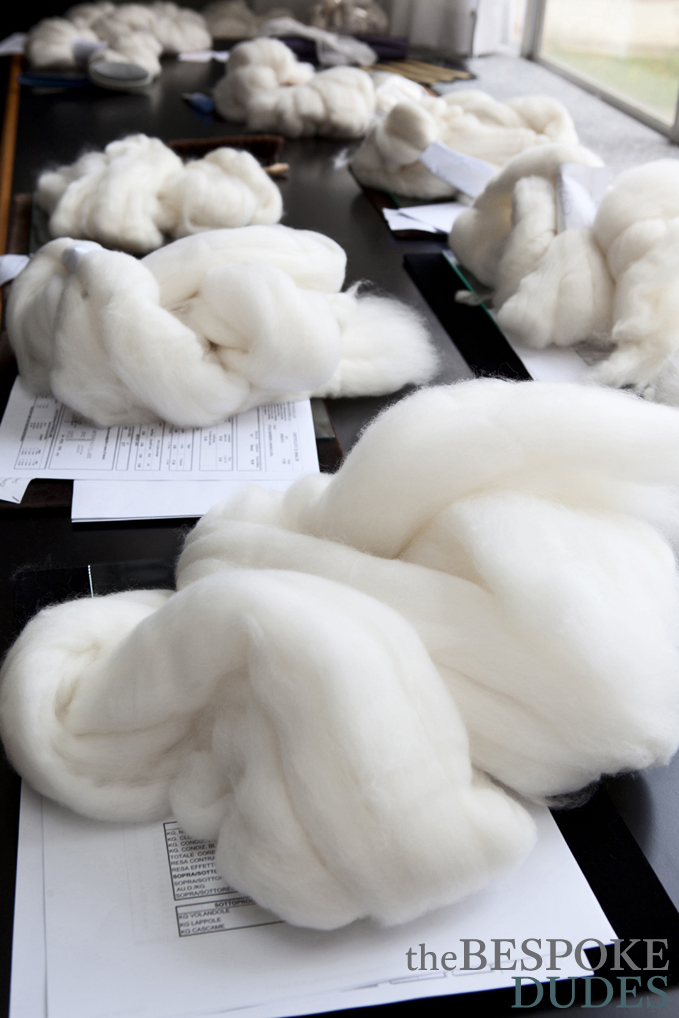Some weeks ago I visited the headquarters of Vitale Barberis Canonico, the oldest woollen mill in the world, based in Pratrivero, near Biella (Piedmont) and had the luck to see in person all the steps of the productive cycle that lead to a finished fabric, starting from the wool of a sheep.
Alcune settimane fa ho fatto visita agli stabilimenti di Vitale Barberis Canonico, il più antico lanificio del mondo, con sede a Pratrivero, in provincia di Biella ed ho avuto la fortuna di vedere di persona tutti gli step del ciclo produttivo che, dalla lana di una pecora, portano alla creazione di un tessuto finito.
More pictures - Altre foto
The history of this company starts in the far 1663, when the ancestor Ajmo Barbero, according to an official document of that time, paid a tribute to the local feudatory with a cloth of saia grisa (grey grisaglie – in Piedmontese dialect) in Pratrivero, to launch his business focused on selling fabrics. Between ‘700 and ‘800, the company gets its actual layout: as of the XVII century there were two branches of the family: one focusing on production of fabrics and the other on sales. As of 1936 VBC will have its actual business name, chosen by Vitale Barberis, granfather of the Creative Director in charge, Francesco Barberis Canonico. Today part of the family is in charge of the technical innovation and raw material purchase, the other to sales and styling. Raw materials processed here are the Cachemire from Alashan in China, the Mohair from South Africa and Merino Wool from Australia.
La storia di quest’azienda ha inizio nel lontano 1663, anno in cui l’avo Ajmo Barbero, secondo un documento ufficiale dell’epoca, pagò un tributo al feudatario locale con una pezza di saia grisa (“saglia grigia” - in dialetto piemontese - ndr) proprio a Pratrivero, per iniziare l’attività di vendita di tessuti. Tra il ‘700 e l’800 l’azienda assume l’assetto attuale: già nel ‘700, infatti, si distinguono due rami all’interno della famiglia, uno dedito alla produzione di panni lana e l’altro alla commercializzazione. Dal 1936 VBC avrà la ragione sociale attuale, scelta da Vitale Barberis, nonno dell’attuale direttore creativo Francesco. Oggi una parte della famiglia è dedita all’innovazione tecnica e acquisto di materie prime, l’altra al commerciale e ufficio stile. Le materie prime trattate sono il Cachemire proveniente da Alashan in Cina, il Mohair dal Sud Africa e la Lana Merino dall’Australia.
Not only the history, but also the numbers of this company are shocking: 103 Million Euros of turnover in 2012 against the 60 of 2010, 7 million meters of fabrics produced every year, that will become 2.5 millions of jackets and suits. More than 80% of the production is exported abroad, 46.000 square meters of premises, distributed on 9 levels in order to follow the slope of the mountain, 30.000 square meters of garden, 360 employees, 50 agents in the world, 2 directly-owned farms in Australia and two headquarters in Biella.
Non solo la storia, ma anche i numeri di VBC sono sbalorditivi: 103 milioni di euro di fatturato nel 2012 contro i 60 del 2010, 7 milioni di metri di tessuto prodotti in un anno per 2,5 milioni tra abiti e giacche, più dell’80% della produzione esportato all’estero, ben 46mila metri quadri di stabilimento distribuiti su 9 livelli per seguire la pendenza della montagna, 30mila metri quadri di giardino, 360 addetti, 50 agenti nel mondo, 2 fattorie di proprietà in Australia e 2 stabilimenti nel biellese.
VBC is a vertically integrated firm, this allows a better control of raw materials, that are not subject to heavy chemical processes, because – as they say here – “you can’t improve something that is already perfect”. As of the ‘70s the company has focused a lot on R&D, in particular on machineries, but the best part is stil the research on fabrics: at VBC they get inspiration from the past, yet there’s a continuous effort to make a product suitable for the everyday life, lightweigth and the taste that characterizes VBC in the world. The product here is conceived to be used in a tailor’s shop rather than in a big company. Moreover, like the winemaker works close to the enologist, as well VBC collaborates with wool classers in its Australian farms: wool professionals in charge of categorizing it; according to the tradition, they should be able to infer the quality of the wool just from the sound of a fleece beaten on a table.
VBC è un lanificio a ciclo verticale, ciò comporta un maggior controllo sulle materie prime, che non vengono sottoposte a finissaggi troppo chimici, in quanto – come dicono qui – “non si può migliorare qualcosa che è già perfetto”. Dagli anni ’70 l’azienda ha puntato molto sulla ricerca e sviluppo, in particolare dei macchinari, anche se il fiore all’occhiello resta la ricerca sul tessuto: ci si ispira sì al passato, ma si cerca sempre di creare un prodotto adatto alle esigenze della vita moderna, con pesi più leggeri e con il gusto che contraddistingue VBC nel mondo. Il prodotto qui è concepito per essere intelato in sartoria piuttosto che termoincollato in una grande azienda. Inoltre, come il viticoltore lavora a stretto contatto con l’enologo, così VBC si avvale dei wool classer nelle sue fattorie australiane: veri e propri professionisti della lana, con il compito di classificarla e che, secondo la tradizione, dovrebbero essere in grado di capirne la qualità dal suono prodotto dal vello sbattuto sul tavolo.
On the left, Davide Fontaneto holds the fleece of a sheep not washed yet
I get in from the oldest part of the premises, renovated ten years ago and visit a room with plenty of white and soft cotton balls, dated files and tools. I feel the strong smell of a fleece neither washed nor brushed yet: I’m at the Wool Office (pictured above), where - among other tests – they also make a particular visual exam of the wool to evaluate the quality of the brushed product coming from Romagnano. From here my tour gets started, guided by Simone Ubertino Rosso, Head of the Marketing Department at VBC, who gently shows me all the steps needed to obtain a ready-to-be-sewn fabric out of the fleece of a sheep.
Entro dalla parte antica dello stabilimento, rimodernata dieci anni fa e visito una stanza con una miriade di batuffoli di soffice lana bianca, cartelle datate e strumenti dall’uso a me sconosciuto. Sento il forte odore del vello di una pecora non ancora lavato: sono all’Ufficio Lane (in foto sopra), dove tra i numerosi test viene effettuato anche il cosiddetto diagramma fibroso, un esame visivo per valutare la qualità del pettinato. Da qui inizio il mio tour dello stabilimento, guidato da Simone Ubertino Rosso, Responsabile della Comunicazione in VBC, che mi mostra accuratamente gli step che portano dalla lana al tessuto pronto per essere confezionato.
From the sheep to the suit, here are – synthetically - the steps of the production cycle, strictly made in Italy:
Purchasing: after careful selection, the wools are purchased from the original makers in Australia Combing: step done in Romagnano. The “bump” (aka “top”) arrives at the firm already washed and brushed. Dyeing: this step can be done at different stages of the productive cycle. There are different kinds of dyeing: top dyeing, yarn dyeing or piece dyeing. Spinning: the fibers are ordered after having been carded Warping: warping machines position the threads parallel to each other, then the threads are winded onto a beam, that is inserted into the warping machine, like a toner in a printer. Weaving: in this step, the warp yarns are interlaced with the weft yarns, with the help of 100 air jet looms. Textile finishing: this step is also called “The Tribunals” because all the fabrics are accuretly checked by the human eye, in order to spot any flaw. In case an impurity is found, the fabric is sent to the “Mending Department”.
Dalla pecora all’abito, ecco - sinteticamente - le fasi del ciclo produttivo rigorosamente svolto in Italia:
Acquisto: dopo un’accurata selezione, le lane vengono acquistate sui mercati di origine australiani Pettinatura: operazione svolta a Romagnano. Il bump (o top) arriva in azienda già lavata e pettinata. Tintoria: ci sono diversi tipi di tintura e quest’operazione può essere svolta in diverse fasi della lavorazione. Si può tingere il top intero (tintura in top, omogenea), il solo filo di lana (tintura in filo) oppure la pezza di tessuto (tintura in pezza) Filatura: trasformazione delle fibre tessili in filato Orditura: si dispongono l’uno vicino all’altro tutti i fili necessari per formare l’ordito di una tela e si avvolgono sul subbio, che sta al telaio come un toner alla sua stampante. Tessitura: i fili di ordito vengono intrecciati con quelli di trama con il prezioso aiuto di 100 telai cabinati e a getto d’aria, che sparano in media 800 colpi d’aria al minuto. Il sistema di insonorizzazione con cabine è stato inventato dall’ingegner Alberto Barberis Canonico per la salute dei propri dipendenti ed è utilizzato nei migliori lanifici nel mondo. Nobilitazione del tessuto: controllo dell’occhio umano, per eliminare impurità e difetti del prodotto (conosciuta anche come “fase dei tribunali”); Se il “tribunale” riscontra dei difetti, il tessuto viene mandato al reparto “Rammendi e Pinzatura”.
The lines of product are three at VBC. The Classic Line features iconic fabrics of the firm like flannels and mohair. The Orient Express is conceived most of all for the Far East, with micro patterns only visible up close. Finally the Vintage Line features refined blends like wool/linen, cotton/silk, wool/silk/linen and is aimed to weekend, more iroinc, with fabrics like seersucker in cotton/silk or shantung in 100% silk.
Le linee di prodotto offerte da VBC sono tre. La Classica identifica i tessuti iconici dell’azienda, come le flanelle cardate, il mohair ed i pettinati fini. L’Orient Express è pensata per il Far East, con microeffetti dal gusto asiatico, con pattern visibili solo avvicinando lo sguardo. Infine, la Vintage con i suoi blend lana/lino, cotone/seta, lana/seta/lino è concepita per il tempo libero, più ironica, con tessuti come il seersucker in cotone/seta o lo shantung in 100% seta per giacca da cocktail.
With almost nine thousands of refined Saxon Merinos wools treated every day, writing today about Vitale Barberis Canonico means talking about a solid Italian company, led by its 13th generation, synonim of a timeless taste, defender of a made-in-Italy that gets more and more subject to foreign attacks, but also of a bright company still writing the story of our Country.
Con circa novemila chili di pregiate lane Saxon Merinos lavorate ogni giorno, parlare oggi di Vitale Barberis Canonico significa parlare di una solida realtà industriale italiana giunta alla tredicesima generazione, sinonimo di un gusto senza tempo, paladina di un made in Italy ahinoi sempre più facilmente aggredibile, nonché di una brillante azienda che continua a scrivere la storia del nostro Bel Paese.
To celebrate its 350 years of wool business, during the textile fair Milano Unica, the woollen mill has created a unique fabric, the Grand Cru 1663, in partnership with Berluti, the high-end menswear brand of the Lvmh group. With 1 Kg of this fabric it is possibile to obtain a 201-km-long thread. This fabric will be used to realize only 200 suits for the best customers of the Grand Measure service of Berluti, in just five selected stores in the world.
E proprio per celebrare i 350 anni di storia, in occasione della Fiera Milano Unica appena conclusasi, l’azienda ha lanciato un tessuto esclusivo, il Grand Cru 1663, in collaborazione con Berluti, il marchio di moda maschile haute de gamme del gruppo Lvmh. Con 1 Kg di questo tessuto si ottiene un filo lungo ben 201 Km. Questo tessuto servirà a realizzare solo 200 abiti, destinati ai migliori clienti del servizio Grand Mesure dell’azienda Berluti, in soli cinque negozi selezionati nel mondo.
Styling Office
Simone Ubertino and his peculiar way of wearing a tieBespoke Hugs,
Fabio Attanasio
If you like what we are doing here, please consider following TBD on Facebook - Tumblr - Instagram - Twitter
Ph. Credits: Giorgio Pesce
From the Sheep to the Suit - Vitale Barberis Canonico
18 September 2013







